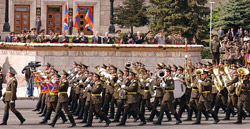May 9 celebrations are getting more and more lavish by the year. It’s surprising that the more deteriorated the Karabakh conflict resolution gets for us, the more solemnly the holiday is celebrated. Military parade, celebrations, holiday concerts, fireworks… and the most important thing is that they say that this was the victory of the whole Armenian nation and that we all strived for that. In fact, it wasn’t all of us who won the war. In fact, during the Shushi liberation many of us had already fled to Russia or were trading gasoline in Yerevan, but we want to emphasize that it was a victory for all of us. The victory has certain “authors”. It was chief commander of the armed forces and President of Armenia, Levon Ter-Petrosyan, Vazgen Manukyan, defense minister at the time, Samvel Babayan, commander of the army in Karabakh, thousands of soldiers, commanders, generals, etc. Very few of those were actually invited to the celebration, but it’s well-known that the list of heroes is always classified in the world. We are concerned about something else.
The liberation of Shushi had exact goals – “long-term” and “short-term” ones. The short-term goal was to save Stepanakert from incessant bombardment and open the road connecting with Armenia. The long-term goal was to liberate the old city of Karabakh and make the region blossom. We reached the first goal and have been trying to solve the second issue for the past 15 years. In Shushi, the population is the same as was 2-3 years after the town’sliberation, and some blocks in Shushi look just the same as they looked on May 10, 1992. It seems time is stopped here.
At present, Shushi is a symbol of victory, an idea to unite the nation. Shortly said, it’s everything but a city. Our nation loves symbols and monuments, and it might even be slightly rude, but we treat to Shushi like we treat our dead relatives or friends. People go to the gravesites on their birthdays, take flowers, kneel at the grave and promise to always commemorate them, but show up only the next year. That’s why Shushi reminds us of a dead city, which resurrects only on every May 9. By the way, this is not only Shushi’s problem. Downtown Yerevan has also turned into a dead city. After it gets dark, take a look at the newly constructed buildings; only a few windows have the lights on. The reason is that Diaspora Armenians and rich people from Armenia buy apartments in those buildings but don’t live there. The same is with Shushi. Diaspora Armenians and rich people from Armenia buy apartments in Shushi as “an element” of fatherland but don’t live there. But the problem is that there are no normal conditions in Shushi for the people of Karabakh to live. That’s why the population decreases all the time.
Every time we talk about this topic, critics say that we need state programs for the rehabilitation of Shushi. We ensure you if we really implement all the programs that exist in Shushi we will have several layers of asphalt. Therefore the problem is not the lack of programs. There is no need to change the attitude. We should implement actual things; instead of going to Shushi to just have a symbolic wedding and show we love our fatherland, we should make sure that people living in Shushi have their own weddings. And that is not only the problem of Shushi or Karabakh, but the whole of Armenia. The same is happening in Armenia. While the number of tourists gradually increases, the population decreases. Tourists buy houses, but our young people don’t get married, because with our average salary they will be able to afford a one-room apartment only after 40 years. That’s why we organize “unity circle dances”. Tourists will love that.

